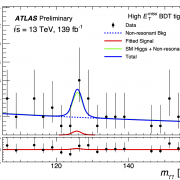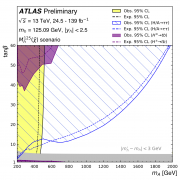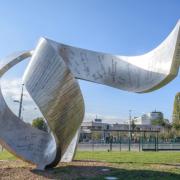Access to Collaboration Site and Physics Results

ATLAS presented new results at the Large Hadron Collider Physics (LHCP) Conference in Columbia University, New York, 2 to 7 June. Many new searches and improved measurements were presented, among which were an updated Higgs boson mass measurement, a search for double Higgs boson production and new searches for Supersymmetry and exotic phenomena.
The latest, most precise value of the Higgs mass measured by ATLAS is 125.36 ±0.41GeV, as seen in two different decay channels (Higgs boson decay into two photons, or into four leptons via two Z bosons).
The updated result has come after months of work by ATLAS physicists to improve detector performance, which involved calibrating certain measurements such as the amount of energy deposited by particles in the detector. These improved calibrations have reduced the overall systematic uncertainty on the Higgs boson mass by about a factor of three, giving a more precise value.
ATLAS has also released results from searches for events where two Higgs bosons are created, in which one decays into two photons and the other into two bottom quarks. Events with two Higgs bosons will eventually be a centrepiece of the LHC programme in the next decades, as they should occur at a very low rate indeed in the Standard Model. The current studies could only have seen much higher rates of such events – as might occur in extensions of the Standard Model – and they also allow us to start understanding other processes which give backgrounds faking such a possible signal. No significant signal was seen and limits on the production cross-section are set.
New results were presented in the continuing search for elusive supersymmetric (SUSY) particles, some of which may be invisible and could be key to understanding dark matter. The analyses searching for "squarks" and "gluinos", which are the SUSY partners of the known quarks and gluons, are sensitive to higher mass scales than before, and still no sign has been found, deepening the mystery of where SUSY – if it exists – could be hiding.
First evidence for the scattering of two massive W bosons was presented and widely talked about (see Michael Kobel's blog post) as it is the first time this type of events was seen and its cross-section measured. Agreement with the Standard Model expectation is found. This and similar measurements will become extremely important during the forthcoming and future LHC running periods, as they will be a key test of the Higgs mechanism of mass generation.
ATLAS has further presented new results from searches for yet unknown bosons that could be heavy cousins of the well-known Z and W bosons of the Standard Model. These searches are interpreted in a large number of new physics scenarios. A new search for miscroscopic black holes and string balls was also shown. This search was able to exclude string ball masses up to 70% of the total energy available in the 8 TeV collisions, demonstrating the large discovery potential available at the forthcoming high-energy LHC run.











